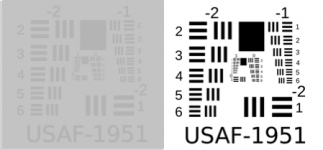-
Welcome to BirdForum, the internet's largest birding community with thousands of members from all over the world. The forums are dedicated to wild birds, birding, binoculars and equipment and all that goes with it.
Please register for an account to take part in the discussions in the forum, post your pictures in the gallery and more.
You are using an out of date browser. It may not display this or other websites correctly.
You should upgrade or use an alternative browser.
You should upgrade or use an alternative browser.
Resolution sharpness and contrast. (1 Viewer)
- Thread starter Paultricounty
- Start date
More options
Who Replied?SeldomPerched
Well-known member
Hi Paul, great post and your last sentence about the Leica and Swarovski 32s is a very good example. Both the latter are fine instruments and while I have been lucky to enjoy their very good points their weaknesses (to my eyes, literally) were frustrating. On a fully overcast day and in or after rain the EL SV (Field Pro in my case) was so sharp and cool-toned but otherwise I found its view lacked character even when not affected by glare, whereas my own inability on occasion to resolve detail when viewing through UVHD Plus detracted from my enjoyment of the colours in their 3D glory.I believe , correct me if I’m wrong, Ultravids and EL’s are about the same vintage in time of introduction and each have gone on to make evolutionarily improvements over time. This is a very interesting dichotomy in perception of optics. Desired use and enjoyment are a delicate balance and come into play as to which one is better, more contrast or more resolution, of course when we’re comparing very equal optical quality instruments. A more similar comparison can be had with the Leica 8x32 UVHD+ and the Swaro 8x32EL SV.
Paul
Delicate balance as you say, and also of course affected by my own eyesight which though still officially (i.e. according to my optician) very good is not what it was. It seems to take longer to adjust to some optics than others.
— — For the record, as far as 32s go I have kept my Zeiss FLs and appreciate them even more as time goes by, for ticking just about every box that matters to me. Every Zeiss I've had has been a pre-owned item but in excellent adjustment and condition, saving a considerable amount of money and helping me appreciate the view! — —
Tom
SeldomPerched
Well-known member
I know, but doesn't it still help us understand the nuance or intended meaning in this forum if we see examples from various contexts? Just like seeing the full corpus of meanings in a dictionary entry for a word. In this instance, not only have we learnt that plastic isn't always a reference to the substance but also its artistic / aesthetic connotations in describing optical performance. Binoculars and photographic lenses presumably share some of these aspects.Oh, joy!
Yet another definition, and from another language, and from photography, which isn’t what we are doing.
dorubird
The unskilled mechanic blames his tools!

Ted Y,
In the photo area there is an example of Voigtlander lenses. Voigtlander has a Nokton 35mm 1.4 lens which is manufactured nowadays in two versions with the same glass and formula but only with different coatings: MC and SC, multi coating and single coating. The MC has a very high contrast and light transmission, and the SC has a low contrast, but both have the same resolution, being the same lens. Many will ask: why would I choose to manufacture an SC lens in the 21st century and why would I choose this version !?! The answer is that the SC variant, not having a high contrast, but has richer gray and colors tones in the shaded areas and also in the lighted areas, making it very good for black and white photography.
While the MC version, precisely because of the high contrast, which is pleasing to the eye, has a lower dynamic range of colors and grays, with abrupt transition between color and gray tones compared to the SC version of the same lens. But again, both having the same resolution, the MC variant with higher contrast seems sharper than the SC variant witch having a more washed out image!
In the photo area there is an example of Voigtlander lenses. Voigtlander has a Nokton 35mm 1.4 lens which is manufactured nowadays in two versions with the same glass and formula but only with different coatings: MC and SC, multi coating and single coating. The MC has a very high contrast and light transmission, and the SC has a low contrast, but both have the same resolution, being the same lens. Many will ask: why would I choose to manufacture an SC lens in the 21st century and why would I choose this version !?! The answer is that the SC variant, not having a high contrast, but has richer gray and colors tones in the shaded areas and also in the lighted areas, making it very good for black and white photography.
While the MC version, precisely because of the high contrast, which is pleasing to the eye, has a lower dynamic range of colors and grays, with abrupt transition between color and gray tones compared to the SC version of the same lens. But again, both having the same resolution, the MC variant with higher contrast seems sharper than the SC variant witch having a more washed out image!
Last edited:
Vespobuteo
Well-known member
Ted Y,
In the photo area there is an example of Voigtlander lenses. Voigtlander has a Nokton 35mm 1.4 lens which is manufactured nowadays in two versions with the same glass and formula but only with different coatings: MC and SC, multi coating and single coating. The MC has a very high contrast and light transmission, and the SC has a low contrast, but both have the same resolution, being the same lens. Many will ask: why would I choose to manufacture an SC lens in the 21st century and why would I choose this version !?! The answer is that the SC variant, not having a high contrast, but has richer gray and colors tones in the shaded areas and also in the lighted areas, making it very good for black and white photography.
While the MC version, precisely because of the high contrast, which is pleasing to the eye, has a lower dynamic range of colors and grays, with abrupt transition between color and gray tones compared to the SC version of the same lens. But again, both having the same resolution, the MC variant with higher contrast seems sharper than the SC variant witch having a more washed out image!
If it looks sharper, it is sharper? A sharp lens imply high resolution. Are the MTF-charts equal? If not, the resolution is not equal.
Last edited:
Vespobuteo
Well-known member
Which are the smallest pattern where you can discern/separate the lines in the left and right picture below?MC looks sharper than SC mainly because his obvious higher contrast, but resolution are comparable
Attachments
Binocollector
Well-known member

But resolution without contrast is useless.MC looks sharper than SC mainly because his obvious higher contrast, but resolution are comparable
Lee
Elseswhere there have been occasional references to 'too much contrast' which I found difficult to imagine but at last, I might have begun to understand how there could be such a thing as excessive contrast.
This could result in it being difficult to see the differences between all the shades of pale red, and of all the shades of pale blue and the same for pale green. And similarly making it difficult to see the differences between all the shades of dark red, of dark blue and of dark green. It would still be possible to differentiate between the different colours, but all the pale shades might become too similar and the same with all the dark shades.
However I am not sure that these extremes of contrast could actually be created in reality.
Lee
This could result in it being difficult to see the differences between all the shades of pale red, and of all the shades of pale blue and the same for pale green. And similarly making it difficult to see the differences between all the shades of dark red, of dark blue and of dark green. It would still be possible to differentiate between the different colours, but all the pale shades might become too similar and the same with all the dark shades.
However I am not sure that these extremes of contrast could actually be created in reality.
Lee
dorubird
The unskilled mechanic blames his tools!

Yes, it is, but it is useless only if the contrast is very low, as in the Vespobuteo from example above. But in reality, no modern optics will have such a low contrast, unless the lens or binoculars are broken. In reality, the differences are much more subtle not like in the exaggerate examples that only want to show the phenomenon better with extremes exemples.But resolution without contrast is useless.
Lee
I showed above that it is like salt and pepper in food. Everyone knows their own desire for contrast. There is for each one a sweetspot for contrast that will help it maintain a sharp image but at the same time not to lose details in shaded and bright areas due to too strong a contrast. It is a sweetspot different for everyone's subjective view,. For me that sweetspot it is give by Zeiss SF 10x42
Last edited:
Vespobuteo
Well-known member
Elseswhere there have been occasional references to 'too much contrast' which I found difficult to imagine but at last, I might have begun to understand how there could be such a thing as excessive contrast.
This could result in it being difficult to see the differences between all the shades of pale red, and of all the shades of pale blue and the same for pale green. And similarly making it difficult to see the differences between all the shades of dark red, of dark blue and of dark green. It would still be possible to differentiate between the different colours, but all the pale shades might become too similar and the same with all the dark shades.
However I am not sure that these extremes of contrast could actually be created in reality.
Lee
In Binocollectors images above the first one looks "flatter" but actually have more overall contrast ("dynamic range") than the latter that looks more punchy (but "gritty" with less discernible gradations) to me.
Last edited:
Vespobuteo
Well-known member
Yes, it is, but it is useless only if the contrast is very low, as in the Vespobuteo from example above. But in reality, no modern optics will have such a low contrast, unless the lens or binoculars are broken. In reality, the differences are much more subtle not like in the exaggerate examples that only want to show the phenomenon better with extremes exemples.
I showed above that it is like salt and pepper in food. Everyone knows their own desire for contrast. There is for each one a sweetspot for contrast that will help it maintain a sharp image but at the same time not to lose details in shaded and bright areas due to too strong a contrast. It is a sweetspot different for everyone's subjective view,. For me that sweetspot it is give by Zeiss SF 10x42
Contrast will affect the measured resolution, because it's a central element in the method:
"The limiting resolution is measured by determining the smallest group of bars, both vertically and horizontally, for which the correct number of bars can be seen. By calculating the contrast between the black and white areas at several different frequencies"
Optical resolution - Wikipedia
 en.wikipedia.org
en.wikipedia.org
Last edited:
I do not know why, I prefer to use a quotation from a better source, like a book about optics. With some context and explanations, not only formulae.Contrast will affect the measured resolution, because it's a central element in the method:
"The limiting resolution is measured by determining the smallest group of bars, both vertically and horizontally, for which the correct number of bars can be seen. By calculating the contrast between the black and white areas at several different frequencies"
Optical resolution - Wikipedia
en.wikipedia.org
No disrespect here.
Last edited:
I do not know why, I prefer to use a quotation from a better source, like a book about optics. With some context and explanations, not only formulae.
No disrespect here.
Handferngläser: Funktion, Leistung, Auswahl : Merlitz, Holger: Amazon.de: Bücher
Handferngläser: Funktion, Leistung, Auswahl | Merlitz, Holger | ISBN: 9783808557747 | Kostenloser Versand für alle Bücher mit Versand und Verkauf duch Amazon.
www.amazon.de
ThanksIt seems 3 different formulae exist for quantifying the contrast.
Probably one single user is equipped to measure the contrast, the Zeiss member.
Vespobuteo
Well-known member
I do not know why, I prefer to use a quotation from a better source, like a book about optics. With some context and explanations, not only formulae.
No disrespect here.
Oh, sorry, didn't think we were on quite that level of academics here..
But check out chapter 11 in Smith, Warren J. (2000), Modern Optical Engineering.
dorubird
The unskilled mechanic blames his tools!

I agree that contrast is very important in the perception of sharpness and contrast must not be missing from the picture! But it is not necessary involved in resolution. It is not necessary for a contrasting image to be full of details, just as for image full of details is also not necessary to be contrasting. I agree that Contrast and Resolution fortunately can often be found together, but not always. There are cases when you have resolution without contrast. The resolution is not about how you see two separated lines (contrasting or non-contrasting), but only if you see them separated or not. If you see them separated, it is said that the optics in question have resolving power. If you don't see them separated, you don't have resolving power (low resolution), even if you see them very easy and contrasting but less of them. You won't see them separated because you have less information in the image. It is explained very well in the link I gave in post
Last edited:
tenex
reality-based
I think contrast has more to do with coatings (as in that MC-or-not Voigtländer lens), while resolution involves minimizing aberrations in the optical design (glass types as well as lens grinding).Is the contrast depending of:
Same for the resolution.
- lens coatings?
- lens material or materials?
I've wondered how the connotations might differ in German. But isn't your photo just an example of shallow depth of field, rather than any quality of a Zeiss lens? (Sorry, I'm more of an Enlightenment than Romantic thinker.)Maybe the reviewer mentioned by @Loud Green Man was German and "plasticity" is the translation of German "Plastizität" which could be used to describe the very quality of the photo below taken with a Zeiss lens.
Well put. This discussion becomes frustrating because few examples actually exist to examine of high resolution with low contrast, or vice versa, at least without going back to historic instruments few have access to (can anyone comment on those?).Yes, it is, but it is useless only if the contrast is very low, as in the Vespobuteo from example above. But in reality, no modern optics will have such a low contrast, unless the lens or binoculars are broken. In reality, the differences are much more subtle not like in the exaggerate examples that only want to show the phenomenon better with extremes exemples.
All we can do is describe the more subtle differences we do see. Somewhat higher contrast (which can suppress shadow detail) has been noted in SFL and EDG, while there are occasional complaints of a more washed-out look in recent Swaros (which could make colors harder to distinguish?). And Zeiss fans maintain that the central resolution of their top models is second to none, while it doesn't seem such a priority for Leica. But all this falls within a fairly narrow range of more than satisfactory performance that isn't much help in developing a gut feeling for the role of each factor.
Last edited:
Users who are viewing this thread
Total: 2 (members: 0, guests: 2)







